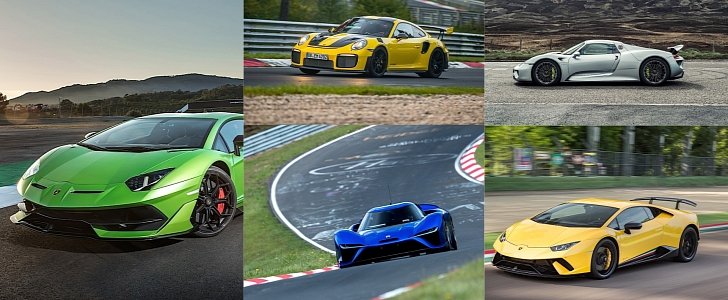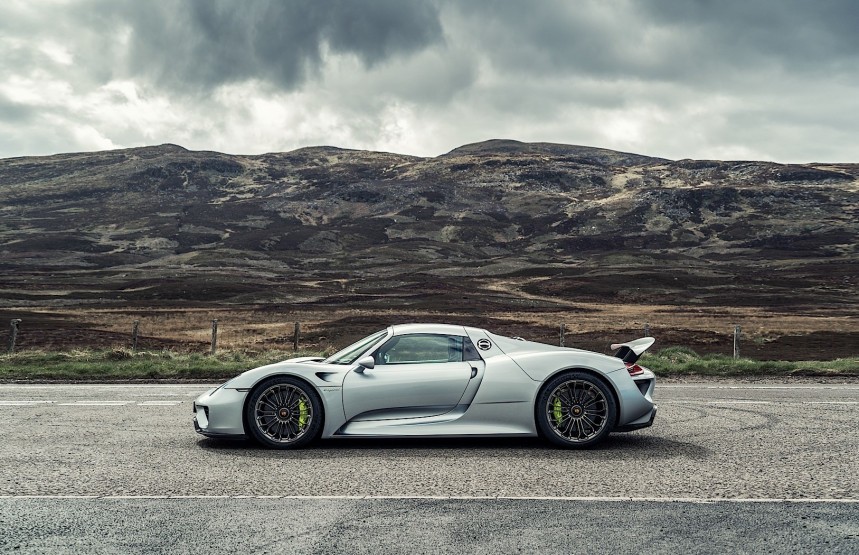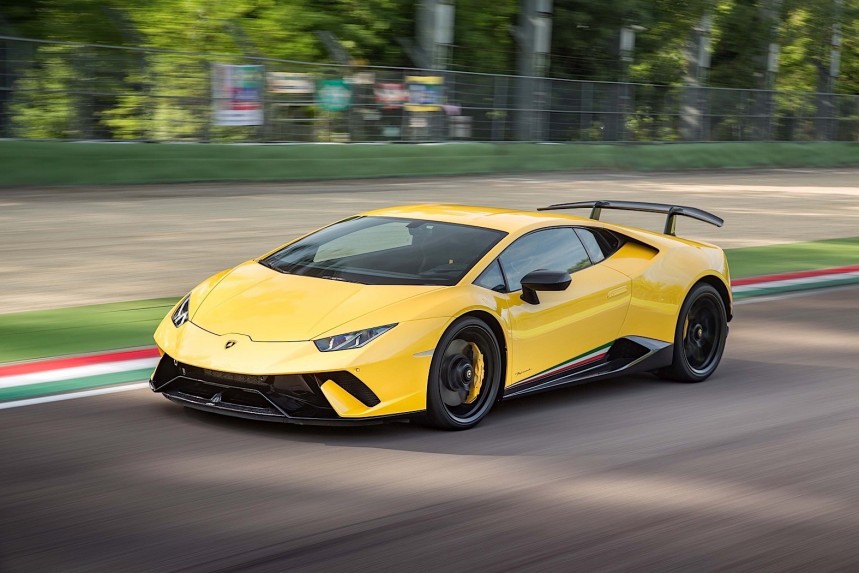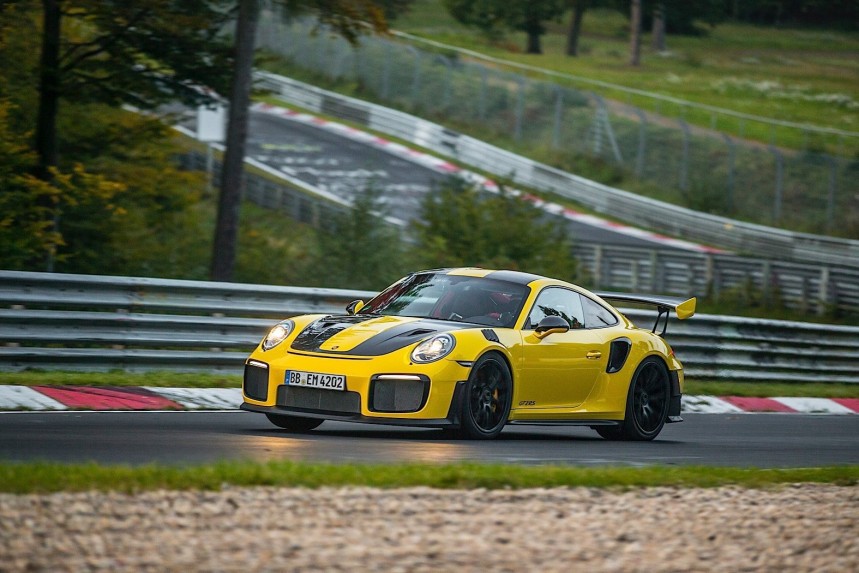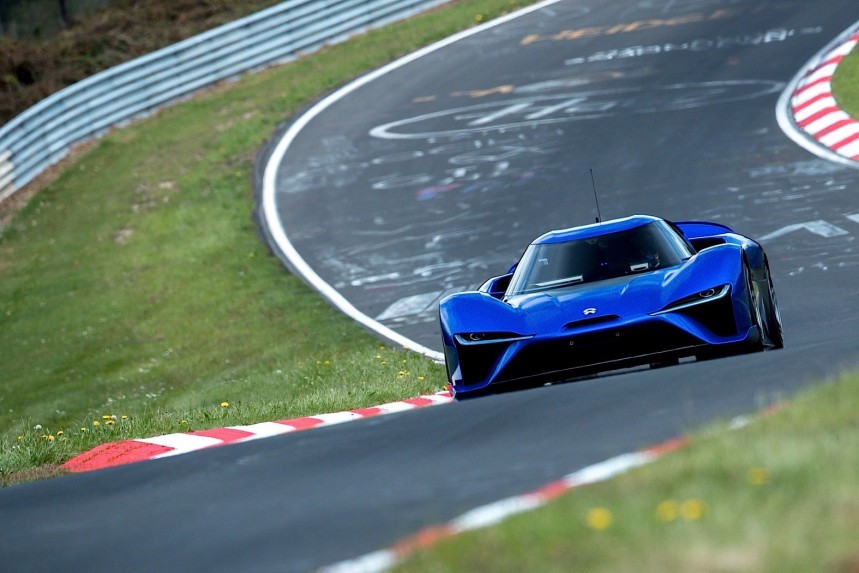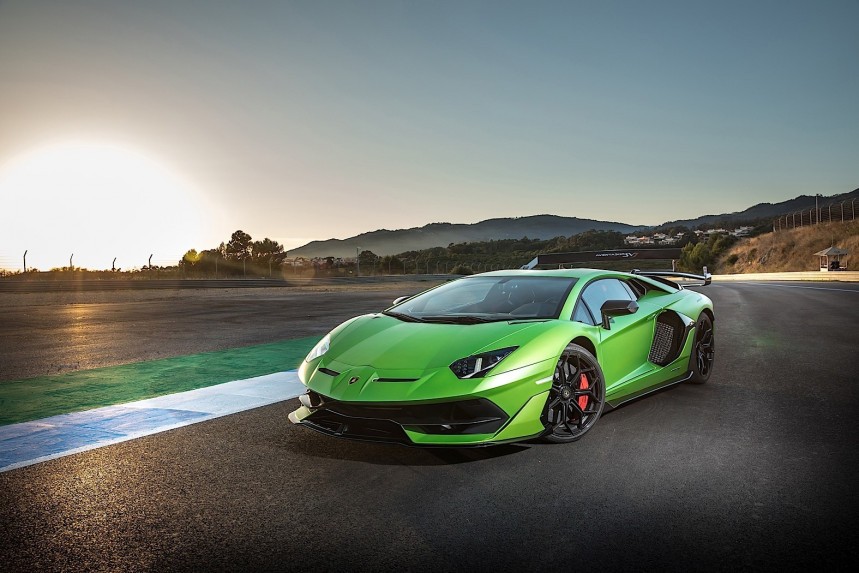All the quarter-mile or 0-60 mph times of the world aren't enough to convince some people that Nurburgring lap times are arguably the most accurate representation of a sports car's true performance.
Nicknamed the Green Hell by Formula 1 legend Jackie Stewart, the circuit was completed in 1927 to showcase the best in German automotive engineering.
After various changes to the layout, only the Nordschleife (North Loop) still remains from the original track, but with a total length of 20.81 km (12.93 miles) including the Gantry to Bridge section, it's still the most demanding circuit in the world.
The “Nurburgring record” frenzy for road cars only started in the late 1990s, with the first yardstick for true sports car being a sub-8 minute lap time. In the second decade of the 21st century is where things really picked up, mostly thanks to advancements in tire technology and aerodynamics.
That said, we decided to check out the five quickest production cars that ever lapped the Nordschleife. All of them posted sub-7 minute laps, and all records were achieved in the last ten years or so. For thos interested in statistics, there is only one electric car on the list while the rest of the records are equally split between Lamborghini and Porsche.
Unveiled at the 2013 Frankfurt Motor Show, the Porsche 918 Spyder is the slowest Nurburgring record-breaker on this list but also the first series production road-legal car to go under the 7-minute barrier.
Only 918 units of the plug-in hybrid hypercar were ever built, with the Porsche being part of a now-legendary trio of hybrid hypercars produced at the same time. The Ferrari LaFerrari and McLaren P1 were both blistering fast on and off the track but the 918 Spyder truly one-upped its rivals in the so-called “hybrid hypercar holy trinity” when it downright smashed all Nurburgring Nordschleife records.
A version fitted with the “Weisach Package” option did a lap of the Green Hell in just 6:57 minutes at the hands of Porsche factory driver Marc Lieb in September 2013, just in time for the hypercar's official public unveiling.
Powered by a naturally-aspirated 4.6-liter V8 derived from the RS Spyder racing car and two electric motors (one on each axle), the 918 Spyder developed a total system output of no less than 886 horsepower. Sent to all four wheels through a 7-speed double-clutch transmission, the limited-edition hypercar could officially accelerate from 0 to 100 kph (62 mph) in just 2.7 seconds, onward to a top speed of over 350 kph (218 mph).
The Performante version of the Huracan is the first Lamborghini production car to go under the 7-minute barrier, also beating the much more expensive Porsche 918 Spyder in the process. While the Porsche made full use of its bespoke Michelin tires and all-wheel-drive with torque vectoring to conquer the 150-something corners of the Nordschleife, the Huracan Performante bet on efficient aerodynamics.
Compared to a standard Huracan, the LP-640-4 Performante is about 40 kg (88 pounds) lighter, has 30 horsepower more and has up to 750 percent more downforce thanks to a system called ALA (Aerodinamica Lamborghini Attiva).
The ALA system is apparently almost magical, since it's not only much lighter than conventional hydraulic-powered systems but can also work many times faster. For example, when the car is driven in a straight line all the spoilers and wings immediately snap into their lowest drag settings. The opposite happens during cornering, simply increasing cornering speeds with the help of exterior air.
The naturally aspirated 5.2-liter V10 sitting in the middle of the car delivers 640 horsepower and 600 Nm (443 lb-ft) of torque, sent to all four wheels through a double-clutch gearbox. Those numbers and the ALA system give the model a 0 to 100 kph (62 mph) acceleration of 2.9 seconds, onward to a top speed of over 325 kph (202 mph).
Despite being essentially part of the same company, Porsche was obviously not contempt with Lamborghini stealing the spotlights regarding the Nurburgring Nordschleife record, so it retaliated with the most powerful production 911 version in history, the 700-horsepower 911 GT2 RS (991).
While for some the GT2 RS is fundamentally a much lighter 911 Turbo S with rear-wheel-drive and some extra aero, the latest model in the GT2 lineage is approximately 80 percent all-new compared to the model it's based on.
Publicly unveiled at the 2017 Goodwood Festival of Speed, the supercar is powered by a twin-turbocharged 3.8-liter flat-six with VTG turbochargers. This allows the powerplant to develop no less than 700 horsepower and 750 Nm (550 lb-ft) of torque, enough to give it a 0-100 kph (62 mph) acceleration time of just 2.8 seconds and a top speed of 340 kph (211 mph).
Those numbers would have been enough to give the “fastest 911 in history” title, but Porsche went the extra mile(s) and obliterated Lamborghini's Nurburgring Nordschleife record for production cars as well. Porsche factory drivers Lars Kern and Nick Tandy managed to complete the 20.6-kilometers (12.8 miles) track in just 6 minutes and 47.3 seconds on their first attempt in September 2017.
While the EP9 is not exactly a production car in the traditional sense, at least six units have been built by the Chinese company and sold among the investors in the carmaker for about $3.2 million a pop. The only electric hypercar on our list, the model was developed in the UK by road division of Formula E team NIO, itself a division of a Chinese start-up in the business of developing autonomous and electric cars.
The all-wheel-drive EP9 has an electric motor and a single-ratio transmission for each of its four wheels, thus featuring an advanced torque vectoring system. Each water-cooled motor develops up to 250 kW and the combined output is exactly 1 MW (1360 metric horsepower).
The motors take their juice from a Li-ion battery pack that weighs 635 kg (1,400 pounds) on its own and gives the car an estimated range of 427 km (265 miles). Since the EP9 is made entirely from carbon fiber and based on FIA Le Mans Prototype regulations, the car only weighs 1,735 kg (3,825 pounds).
Adjustable aerodynamics are apparently responsible for no less than 2500 kg (5,500 pounds) of downforce at 240 kph (150 mph), or almost twice as much as a Formula 1 car. In conjunction with the torque vectoring system, it can make the EP9 corner at up to 2.53 Gs, which is nothing short of spectacular for a road car.
Just as amazing is the 6:45.90 minutes Nurburgring North Loop time, which was actually achieved before the 911 GT2 RS (991) but since there was only one car built at the time it didn't quite qualify as a production model.
The most powerful road-going Lamborghini in history is unsurprisingly quicker on the Nordschleife than its baby brother, the Huracan Performante. Unveiled at the 2018 Pebble Beach Concours d'Elegance, the Aventador LP700-4 SVJ (Super Veloce Jota) proves that ICE-powered cars still have a chance on track against monster EVs like the NIO EP9.
The SVJ is powered by a naturally aspirated 6.5-liter V12 that develops a staggering 770 horsepower and 720 Nm (531 lb-ft) of torque. Thanks to the substantial use of carbon fiber parts and an exhaust system made from titanium, the car is about 50 kilograms lighter than a “conventional” Aventador.
With the extra power, the LP770-4 SVJ can go from 0 to 100 kph (62 mph) in just 2.8 seconds and then hit a top speed of at least 350 kph (217 mph). Equipped with optional but still street-legal Pirelli P Zero Trofeo R tires, the car was driven by Lamborghini factory driver Marco Mapelli in a staggering 6 minutes and 44.97 seconds on the Green Hell in July 2018.
This time not only beat the NIO EP9 record but will probably remain the quickest time of the current era at the Nurburgring. Just like on the Huracan Performante, the ace in the SVJ's sleeve was the Aerodinamica Lamborghini Attiva (ALA) system, which gives the car up to 40 percent more downforce compared to the more conventional Aventador SV.
After various changes to the layout, only the Nordschleife (North Loop) still remains from the original track, but with a total length of 20.81 km (12.93 miles) including the Gantry to Bridge section, it's still the most demanding circuit in the world.
The “Nurburgring record” frenzy for road cars only started in the late 1990s, with the first yardstick for true sports car being a sub-8 minute lap time. In the second decade of the 21st century is where things really picked up, mostly thanks to advancements in tire technology and aerodynamics.
That said, we decided to check out the five quickest production cars that ever lapped the Nordschleife. All of them posted sub-7 minute laps, and all records were achieved in the last ten years or so. For thos interested in statistics, there is only one electric car on the list while the rest of the records are equally split between Lamborghini and Porsche.
Porsche 918 Spyder 6:57 minutes
Only 918 units of the plug-in hybrid hypercar were ever built, with the Porsche being part of a now-legendary trio of hybrid hypercars produced at the same time. The Ferrari LaFerrari and McLaren P1 were both blistering fast on and off the track but the 918 Spyder truly one-upped its rivals in the so-called “hybrid hypercar holy trinity” when it downright smashed all Nurburgring Nordschleife records.
A version fitted with the “Weisach Package” option did a lap of the Green Hell in just 6:57 minutes at the hands of Porsche factory driver Marc Lieb in September 2013, just in time for the hypercar's official public unveiling.
Powered by a naturally-aspirated 4.6-liter V8 derived from the RS Spyder racing car and two electric motors (one on each axle), the 918 Spyder developed a total system output of no less than 886 horsepower. Sent to all four wheels through a 7-speed double-clutch transmission, the limited-edition hypercar could officially accelerate from 0 to 100 kph (62 mph) in just 2.7 seconds, onward to a top speed of over 350 kph (218 mph).
Lamborghini Huracan Performante 6:52.01 minutes
Compared to a standard Huracan, the LP-640-4 Performante is about 40 kg (88 pounds) lighter, has 30 horsepower more and has up to 750 percent more downforce thanks to a system called ALA (Aerodinamica Lamborghini Attiva).
The ALA system is apparently almost magical, since it's not only much lighter than conventional hydraulic-powered systems but can also work many times faster. For example, when the car is driven in a straight line all the spoilers and wings immediately snap into their lowest drag settings. The opposite happens during cornering, simply increasing cornering speeds with the help of exterior air.
The naturally aspirated 5.2-liter V10 sitting in the middle of the car delivers 640 horsepower and 600 Nm (443 lb-ft) of torque, sent to all four wheels through a double-clutch gearbox. Those numbers and the ALA system give the model a 0 to 100 kph (62 mph) acceleration of 2.9 seconds, onward to a top speed of over 325 kph (202 mph).
Porsche 911 GT2 RS (991) 6:47.30 minutes
While for some the GT2 RS is fundamentally a much lighter 911 Turbo S with rear-wheel-drive and some extra aero, the latest model in the GT2 lineage is approximately 80 percent all-new compared to the model it's based on.
Publicly unveiled at the 2017 Goodwood Festival of Speed, the supercar is powered by a twin-turbocharged 3.8-liter flat-six with VTG turbochargers. This allows the powerplant to develop no less than 700 horsepower and 750 Nm (550 lb-ft) of torque, enough to give it a 0-100 kph (62 mph) acceleration time of just 2.8 seconds and a top speed of 340 kph (211 mph).
Those numbers would have been enough to give the “fastest 911 in history” title, but Porsche went the extra mile(s) and obliterated Lamborghini's Nurburgring Nordschleife record for production cars as well. Porsche factory drivers Lars Kern and Nick Tandy managed to complete the 20.6-kilometers (12.8 miles) track in just 6 minutes and 47.3 seconds on their first attempt in September 2017.
NIO EP9 6:45.90 minutes
The all-wheel-drive EP9 has an electric motor and a single-ratio transmission for each of its four wheels, thus featuring an advanced torque vectoring system. Each water-cooled motor develops up to 250 kW and the combined output is exactly 1 MW (1360 metric horsepower).
The motors take their juice from a Li-ion battery pack that weighs 635 kg (1,400 pounds) on its own and gives the car an estimated range of 427 km (265 miles). Since the EP9 is made entirely from carbon fiber and based on FIA Le Mans Prototype regulations, the car only weighs 1,735 kg (3,825 pounds).
Adjustable aerodynamics are apparently responsible for no less than 2500 kg (5,500 pounds) of downforce at 240 kph (150 mph), or almost twice as much as a Formula 1 car. In conjunction with the torque vectoring system, it can make the EP9 corner at up to 2.53 Gs, which is nothing short of spectacular for a road car.
Just as amazing is the 6:45.90 minutes Nurburgring North Loop time, which was actually achieved before the 911 GT2 RS (991) but since there was only one car built at the time it didn't quite qualify as a production model.
Lamborghini Aventador LP770-4 SVJ 6:44.97 minutes
The SVJ is powered by a naturally aspirated 6.5-liter V12 that develops a staggering 770 horsepower and 720 Nm (531 lb-ft) of torque. Thanks to the substantial use of carbon fiber parts and an exhaust system made from titanium, the car is about 50 kilograms lighter than a “conventional” Aventador.
With the extra power, the LP770-4 SVJ can go from 0 to 100 kph (62 mph) in just 2.8 seconds and then hit a top speed of at least 350 kph (217 mph). Equipped with optional but still street-legal Pirelli P Zero Trofeo R tires, the car was driven by Lamborghini factory driver Marco Mapelli in a staggering 6 minutes and 44.97 seconds on the Green Hell in July 2018.
This time not only beat the NIO EP9 record but will probably remain the quickest time of the current era at the Nurburgring. Just like on the Huracan Performante, the ace in the SVJ's sleeve was the Aerodinamica Lamborghini Attiva (ALA) system, which gives the car up to 40 percent more downforce compared to the more conventional Aventador SV.
